Lake Erie Full-Day Fishing: Top-Rated Charters
- Published Date: July 16, 2025
- Fishing
- Buffalo, NY
- $320 - $400 price range
- Updated Date: December 7, 2025
Summary
%2F%2Fusers%2F62a976e9-eb24-4dca-8698-3a9e06d0f6be%2Fratecard%2F278371042_105086065511419_1832185668231861537_n.jpg&w=1200&q=75)
Lake Erie's Finest Catches
Full Day Lake Erie Fishing: Land Trophy Walleye & More
Ready to reel in some monster walleye on Lake Erie? This full-day charter puts you right on the honey holes where trophy fish are biting. We'll spend 7 hours trolling the productive waters off Buffalo and Dunkirk, targeting not just walleye but also smallmouth bass, trout, and more. With all the gear provided and fish cleaning included, you just need to focus on landing the big one. Whether you're an experienced angler or trying Lake Erie fishing for the first time, our seasoned captains know how to put you on the fish.
What to Expect on the Water
We'll kick things off early, meeting at the dock before sunrise to load up and head out. The boat's equipped with top-notch electronics to find the fish, plus downriggers and planer boards to get our lines right where they need to be. As we troll, you'll learn pro techniques for presenting lures and setting the hook when a walleye strikes. Don't worry if you're new to this - the crew's always happy to show you the ropes. We'll cover plenty of water throughout the day, adjusting our tactics based on what's working. Expect a laid-back vibe with plenty of laughs between bites, and of course, some friendly competition to see who lands the biggest fish of the day.
Trolling Tactics & Top Gear
Trolling's the name of the game on Lake Erie, and we've got it down to a science. We'll be running multiple lines off the back of the boat, using a mix of crankbaits, spoons, and nightcrawler harnesses. The setup changes with the seasons - in early summer, we might focus on suspended fish with deep-diving cranks, while later in the year, we'll often switch to bottom bouncers to target walleye hugging the lake bed. All the rods, reels, and tackle are provided, so you don't need to worry about bringing your own gear. Just make sure to pack some snacks, drinks, and weather-appropriate clothing. Oh, and don't forget your camera - you'll want proof when you land that 10-pound walleye!
Species You'll Want to Hook
Walleye are the star of the show on Lake Erie, and for good reason. These golden-eyed predators can grow to trophy sizes here, with 5-8 pounders being common and double-digit fish always a possibility. They're known for their aggressive strikes and delicious white flesh - perfect for a fish fry. Spring and fall tend to be prime walleye seasons, but we catch them year-round.
Smallmouth bass are another Lake Erie favorite. These bruisers put up an incredible fight, often leaping clear out of the water when hooked. We typically target them in shallower water near structure, using crankbaits or tube jigs. The average size is impressive, with 3-5 pound fish being the norm and 6+ pounders not uncommon.
Don't sleep on the trout fishing either. Lake trout are available year-round, while steelhead make seasonal runs. Lake trout tend to hang deep, so we'll often use downriggers to get our lines down 80-100 feet where the big ones lurk. Steelhead, on the other hand, are often found in the top part of the water column and are known for their acrobatic fights. Both species can reach sizes of 10+ pounds in Lake Erie.
Yellow perch might be smaller than our other targets, but what they lack in size they make up for in numbers and taste. These tasty panfish often school up in huge numbers, providing fast action when we find them. They're a great option if you want to bring home a mess of fish for the dinner table.
Why Anglers Keep Coming Back
Lake Erie's reputation as a world-class fishery isn't hype - it's the real deal. The sheer number of fish, combined with the potential for true trophy catches, keeps anglers coming back year after year. But it's not just about the fish. There's something special about being out on the open water of one of the Great Lakes, watching the sun rise over the horizon as you wait for that first bite of the day. And let's not forget the camaraderie - whether you're out with old fishing buddies or making new friends on the boat, there's nothing like swapping stories and sharing the excitement of a good catch.
Time to Book Your Spot
If you're itching to experience some of the best freshwater fishing in North America, this Lake Erie charter is calling your name. With professional gear, expert guidance, and even fish cleaning included, we've taken care of all the details so you can focus on the fun part - catching fish. Remember, you can bring along extra anglers for just $70 per person, making this a great option for a group outing or family adventure. And with a generous 3-day cancellation policy, you can book with confidence. Don't let another season slip by without getting out on Lake Erie - reserve your spot today and get ready for an epic day of fishing!
Learn more about the species
American Yellow Perch
American Yellow Perch (Perca Flavescens) Description
The American Yellow Perch are one of the smaller-sized members of the perch family, Percidae. They have an elongated, oval body with a long blunt snout. Like most perches, it has two separate dorsal fins. The first dorsal fin contains 12-14 spines and 12 soft rays. The second has 2-3 spines and 8 soft rays. They are a golden yellow, however, their color can sometimes vary from bright green to olive green or golden brown. Their sides have a pattern of vertical bars. Their pectoral fins are transparent and amber in color. The juveniles are paler and a whitish color.
Yellow Perch have a large number of sharp teeth. They are rough to the touch because of their overlapping, comb-like scales.
Size and Diet
The largest recorded American Yellow Perch is 20 inches although they are more commonly found at 7.5 inches and 2 pounds.
Yellow Perch eat a variety of invertebrates such as insects, mollusks, chitons, snails, and worms. squids, along with small fish.
Spawning
The Yellow Perch spawning occurs in the spring when water temperatures rise above 36 degrees and typically occurs at night or early morning. Along the shorelines, the females extrude their eggs in long ribbons. You will find them draped along submerged vegetation, dead branches, and trees. Once the females extrude their eggs, groups of male yellow perch will follow and fertilize them.
Interesting Facts
Yellow perch is one of the easiest fish to catch in all seasons and tastes great. It makes up around 85% of the sport fish caught in Lake Michigan.
Common names for the perch are yellow perch, American perch, and lake perch
In the Northeastern United States, these Perch are an extremely important food source for birds. The cormorants specifically target yellow perch as their primary prey. Other birds that also prey on them include eagles, gulls, hawks, and many more.
Survival rates of juvenile yellow perch are low because they are much preyed upon.
Fishing Technique
To catch these fish, a good ultralight spinning or spin-cast combo spooled with 2-4lb (1-2kg) mono works well.
Most yellow perch catches will be made with live bait. You can't go wrong with minnows, leeches, or worms, but you can use almost any insect or small fish or fish parts.
If you are looking at lures, small jigs, spinners, and jigging spoons will work.
Yellow perch are schooling fish and it's not unusual to see a school of 200 fish. Go get'em!
Habitat and Distribution
These Perch live in ponds, lakes, creeks, and slow-flowing rivers. You will find them in heavily vegetated waters among reeds, weeds, docks, and other structures. You may find large schools of Yellow Perch near the shore during the spring. They can also be found in brackish water.
Yellow Perch are found in the rivers of the Atlantic and Arctic Oceans, the Great Lakes, the Mississippi River basin, and throughout the majority of the northeast United States and parts of Canada.
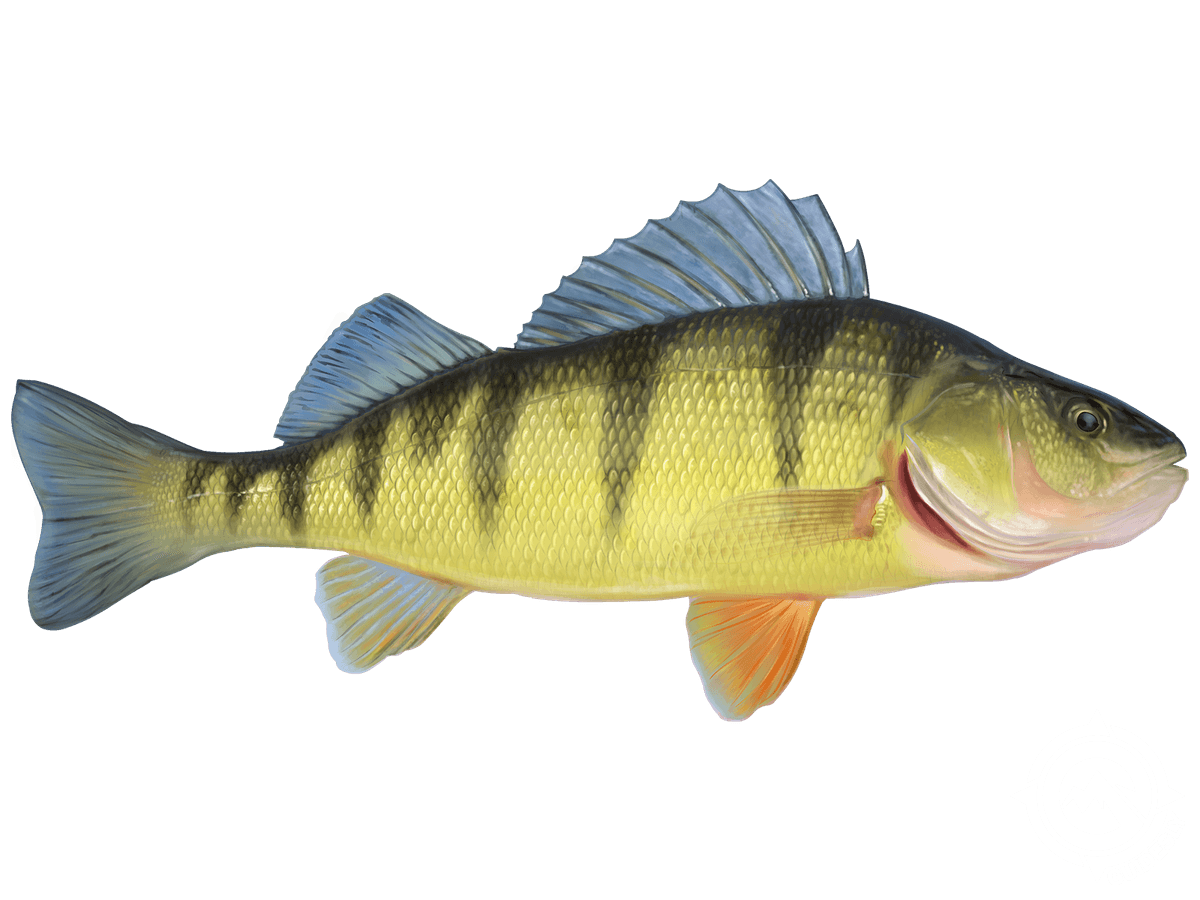
Lake Trout
## Lake Trout (Salvelinus Namaycush) The lake trout is the largest member of the char family. Lake trout have a grey to green coloring with a lighter belly, the fish also have yellow to cream colored markings on its body and fins as well. Lake trout are known to be slow growing, and mature late in their lives and have low reproductive potential when compared to other species of game fish. ## Lake Trout Habitat Lake trout are a cold-water species, like a cold water species, they rely on high levels of oxygenation to survive. Lake trout are a very popular game fish and are the only major native game fish to inhabit deep and cold water of oligotrophic lakes, like those of northern Canada and the Great Lakes region. Most of the time the Salvelinus Namaycush can be found in these deep and cold water lakes suspended in the middle of the basin, sometimes at deep depths. 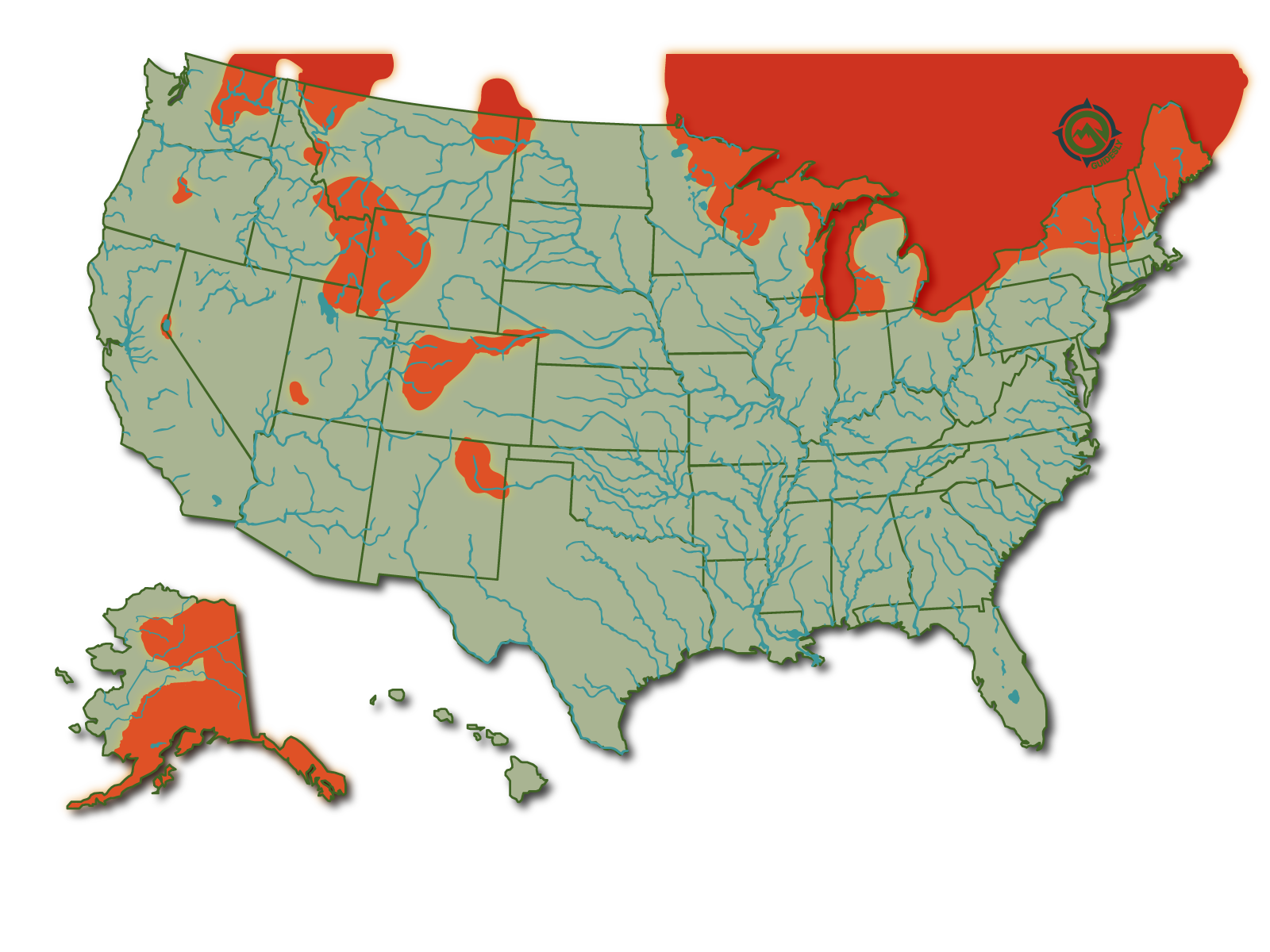 Lake trout have a relatively narrow distribution and range when compared to other species. Lake trout are found in the northern reaches of North America including the Great Lakes region and throughout Canada and parts of Alaska and to a lesser extent the Northeastern United States. Lake trout have also been artificially stocked in Europe like the Scandanavian country of Sweden. New Zealand, South America, and even parts of Asia have stocked populations of lake trout as well. ## Lake Trout Size Lake Trout are the largest of the char species, with sizes of 15-40 pounds not uncommon, and averages lengths of 24-36 inches. The world record Lake trout were caught on rod and reel Great Bear Lake in the Northwest Territories of Canada and was 72 pounds and had a length of 52 inches. ## Lake Trout Facts Lake Trout are known to hybridize with Brook Trout, creating a hybrid species known as “Splake” hybrid fish such as splake are usually sterile. And Fisheries around North America raise and stock splake in bodies of water to provide more sport fishing opportunities for fishermen. Due to being a cold water species Lake Trout in the southern reaches of their distribution and range tend to live in very deep water during the summer months, where the water temperatures are more suited to their needs. ## Lake Trout Fishing The best time to fish for Lake Trout really depends on factors like weather, These fish prefer to avoid bright light, so a good time to fish them are typically in overcast or low light conditions. Not only do lake trout prefer these conditions they also generally feed more frequently during these times. Most importantly is finding bodies of water with which lake trout inhabit, as they have such particular habitats and not all lakes can support them. Seeking out the deep water areas of these lakes are a great place to start. In the spring immediately after ice out can be a great time for fishermen to pursue lake trout, with the colder water temperature the fish can be found relatively shallow. ## Lake Trout Fishing Lures Jigging is the preferred method when targeting this species due to fishing in deep water. Lures like the Rapala Jigging Rap and lure that imitate wounded baitfish work great. Other great options are lures like jig heads with soft plastic paddle tail swimbaits used in a jigging fashion, skirted jigs and bladed jigging spoons are also great options. Crankbaits are great if the Fish are higher in the water column or if you're trolling, allowing the crankbaits to reach their maximum depth. Don't count out old fashioned spoons either, they can be a great tool to catch lake trout. ## The Trout Family Trout are members of the family Salmonidae, order Salmoniformes. The native trout family is closely related to salmon. A top fly fishing family of fish that are both tremendous game fish and tasty eating fish. Found in small streams, large rivers, and any trout stream with the right water temperature, aquatic insects, and clean water. The trout species is usually restricted to freshwater, though a few types migrate to the sea between spawnings. Members of the trout species include [Rainbow Trout](https://guidesly.com/fishing/fish-species/rainbow-trout), [Brown Trout](https://guidesly.com/fishing/fish-species/brown-trout), [Brook Trout](https://guidesly.com/fishing/fish-species/brook-trout), [Lake Trout](https://guidesly.com/fishing/fish-species/lake-trout), [Steelhead Trout](https://guidesly.com/fishing/fish-species/steelhead), [Bull Trout](https://guidesly.com/fishing/fish-species/bull-trout), [Cutthroat Trout](https://guidesly.com/fishing/fish-species/cutthroat-trout), [Apache Trout](https://guidesly.com/fishing/fish-species/apache-trout) and several other smaller species.

Smallmouth Bass
Smallmouth Bass (Micropterus Dolomieu) Description
Smallmouth Bass belongs to the Sunfish family (Centrarchidae) and is a popular freshwater fish among anglers. Smallmouth Bass has a dark green or black color body, with vertical dark brown stripes that usually fade with age, and the color contrast may vary depending on the fish’s habitat. Their eyes are red or brown. They have two dorsal fins; the front one has 10 fin spines while the other has 10 to 15 soft rays.

Female Smallmouth bass are usually larger in size than males. The average size of smallmouth bass can be 18–20 inches. On average, they usually live only 5 to 6 years but can survive up to 15 years. Smallmouth bass found in lakes are larger than those found in streams and ponds. Females usually weigh from three to six pounds, while the males are around 2 pounds.
Smallmouth Bass Habitat
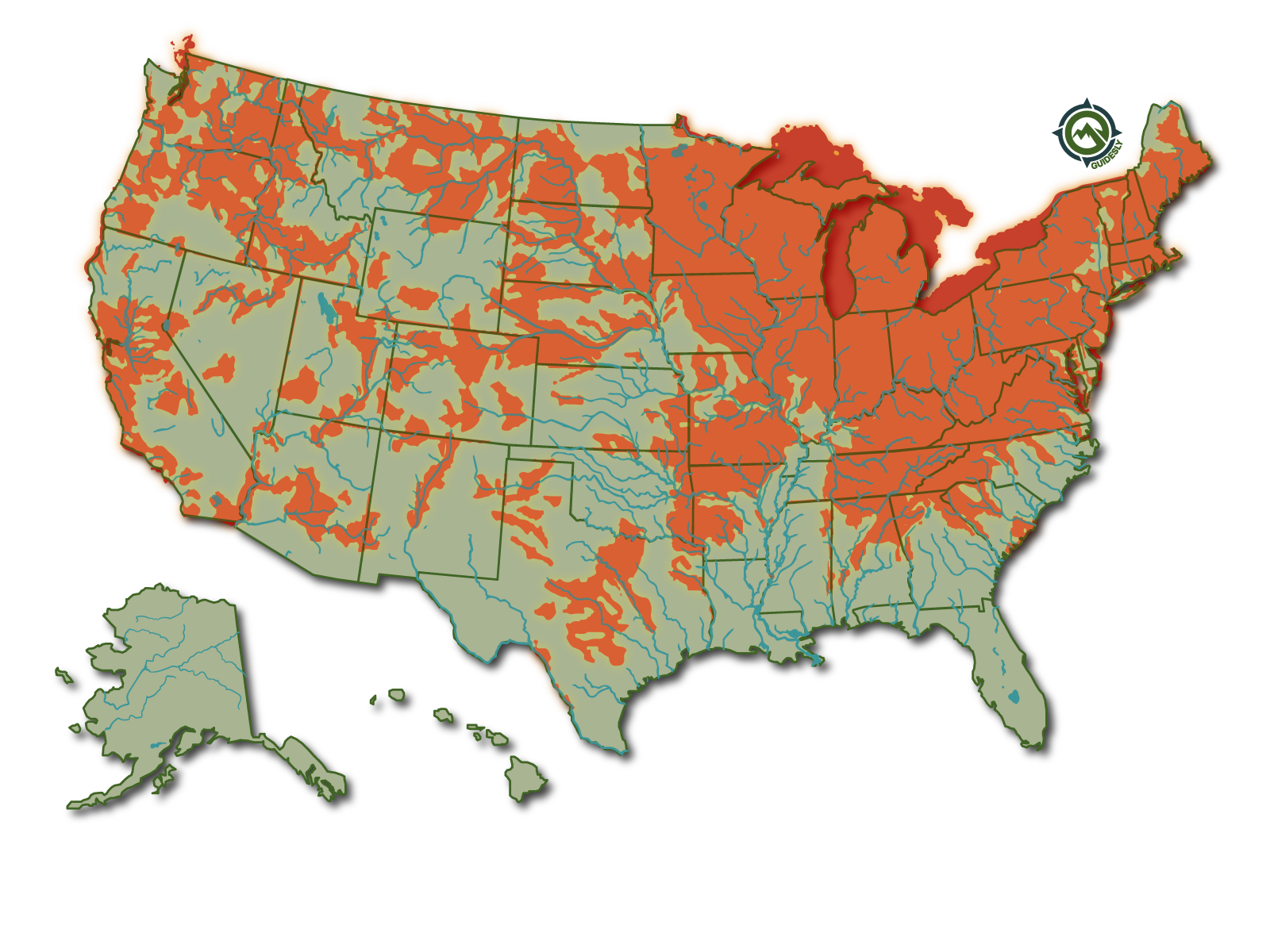
This bass species can be found in clear waters, such as ponds, lakes, and rivers. They prefer rubble and rocky bottoms. Smallmouth bass also prefer moderate temperatures, and they will swim deeper in the cooler water during summer.
Spawning
Smallmouth Bass spawn March-May when water temperatures reach between 59 and 64 degrees. The males build nests in the shallow waters of lakes and rivers. The nest is built building within 150 yards of where the male built his nest the previous year.
Diet
The Smallmouth Bass eats small fish, crayfish, and insects. They hide behind a fallen tree or a rock and attack when the prey is near.
Fishing Techniques - How to Catch Smallmouth Bass
A light breeze and calm waters are best suited to catch Smallmouth Bass. In spring and fall, they like to swim in open waters during bright days and warm temperatures. In summer, they swim deep under cooler water and are harder to find. It is best to fish for Smallmouth early morning or late evening.
Smallmouth bass are fighters. A spinning rod of light to medium action with a 6 to 10 pounds test line is recommended.
There are plenty of baits and lures that work successfully to catch these fish; insects, jigs, minnows, plugs, plastic worms, spoons and night crawlers. A favorite of anglers is to use spinning baits that when rigged weightless, can hang on top of the water. When the fish are in deeper water during the summer, use a rig with a weighted vertical drop hook.
Fly-fishing Smallmouth Bass is popular due to their abundance and strength. When you want to cast into deeper water, use a 6, 7 or 8 weight rod. This will be suitable for strong winds, landing larger fish, and a long cast. A longer rod, 81/2- to 9-foot, is good when you need accuracy for casting near shoreline structures or long-distance casting.
Is Smallmouth Bass Good to Eat
Smallmouth bass have a firm filet with a mild, yet distinct flavor that pairs perfectly with a variety of seasonings and cooking methods. So whether you prefer grilling, frying, or baking your catch, smallmouth bass is a tasty and versatile option that you won't want to miss out on. What's more, smallmouth bass are a healthy food option, as they are excellent sources of protein and Omega-3 fatty acids.
With any freshwater fish, you need to be mindful of the water you are fishing. Make sure if you are eating your catch, the water is clean and be aware that freshwater fish should always be cooked.
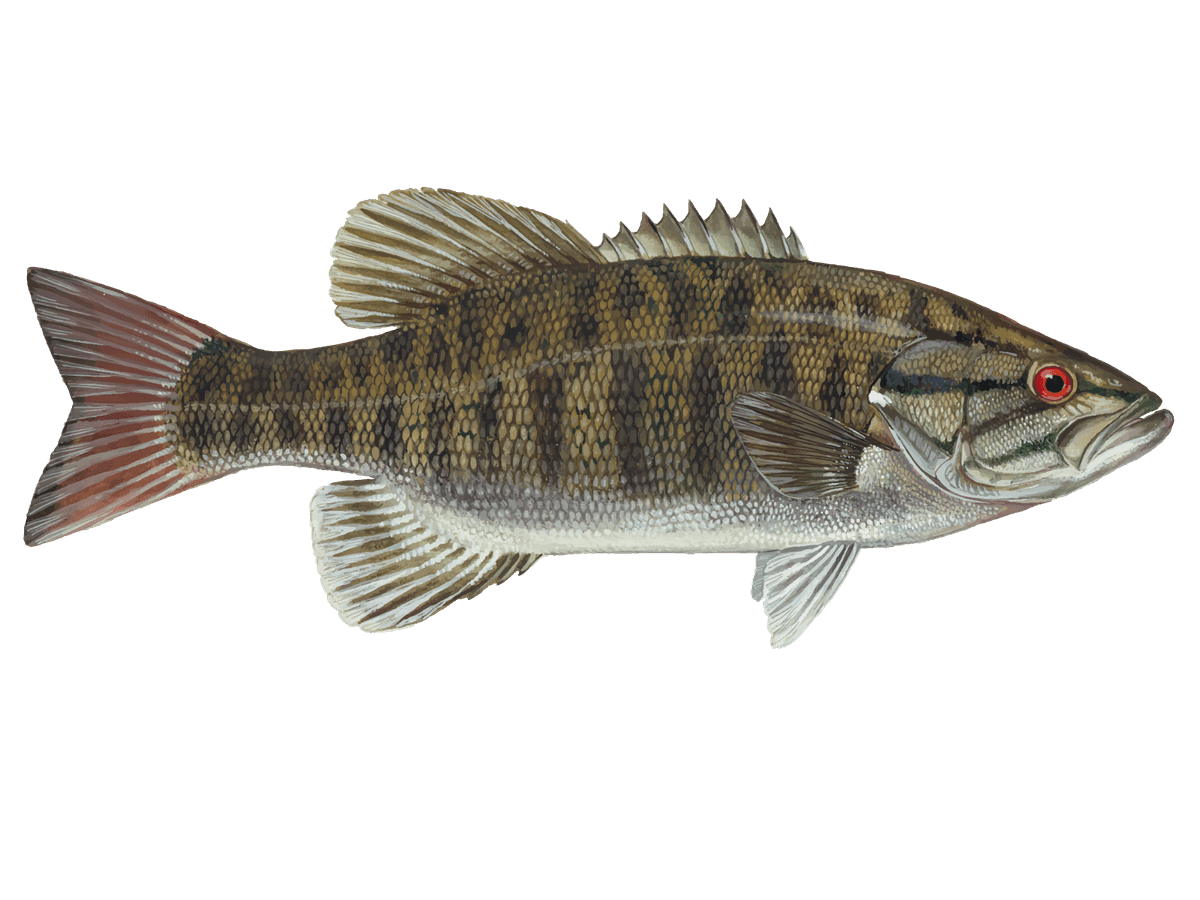
Steelhead Trout
Steelhead (Oncorhynchus mykiss) Fish Description
Steelhead (often called steelhead trout) is an anadromous (sea-run) form of the coastal rainbow trout that typically returns to freshwater to spawn after living two to three years in the ocean. Steelhead and Rainbow Trout are actually the same species, but they have different lifestyles. Steelhead spends part of their lives in the sea before going to rivers to breed—while rainbow trout spend their lives entirely in freshwater. Because of this, rainbow trout and steelhead are different in appearance, most noticeably in size and color. Rainbow trout derive their name from their beautiful, multi-hued coloration. Their bodies are blue, green, or yellowish, shading to silvery-white on the underside, with a horizontal pink-red stripe running from the gills to the tail and black spots along their backs. Steelhead is generally more streamlined in shape and silvery or brassy in color as adults, with black spots on their backs earning them their name. Steelhead has a streamlined body. They have black spots on the back and a pinkish-red stripe is present between the tail and the gills. Unlike rainbow trout, its body is more brassy and silvery in color. The anal fins contain 10 -12 rays.
Steelhead Trout Habitat and Distribution
Steelhead trout come and occupy freshwater lakes and streams during their lives. As a protective cover, Steelhead trout use wood, boulders, and vegetation. For spawning, Steelhead trout returns to freshwater bodies for a small period and spends most of their life in sea or estuaries.
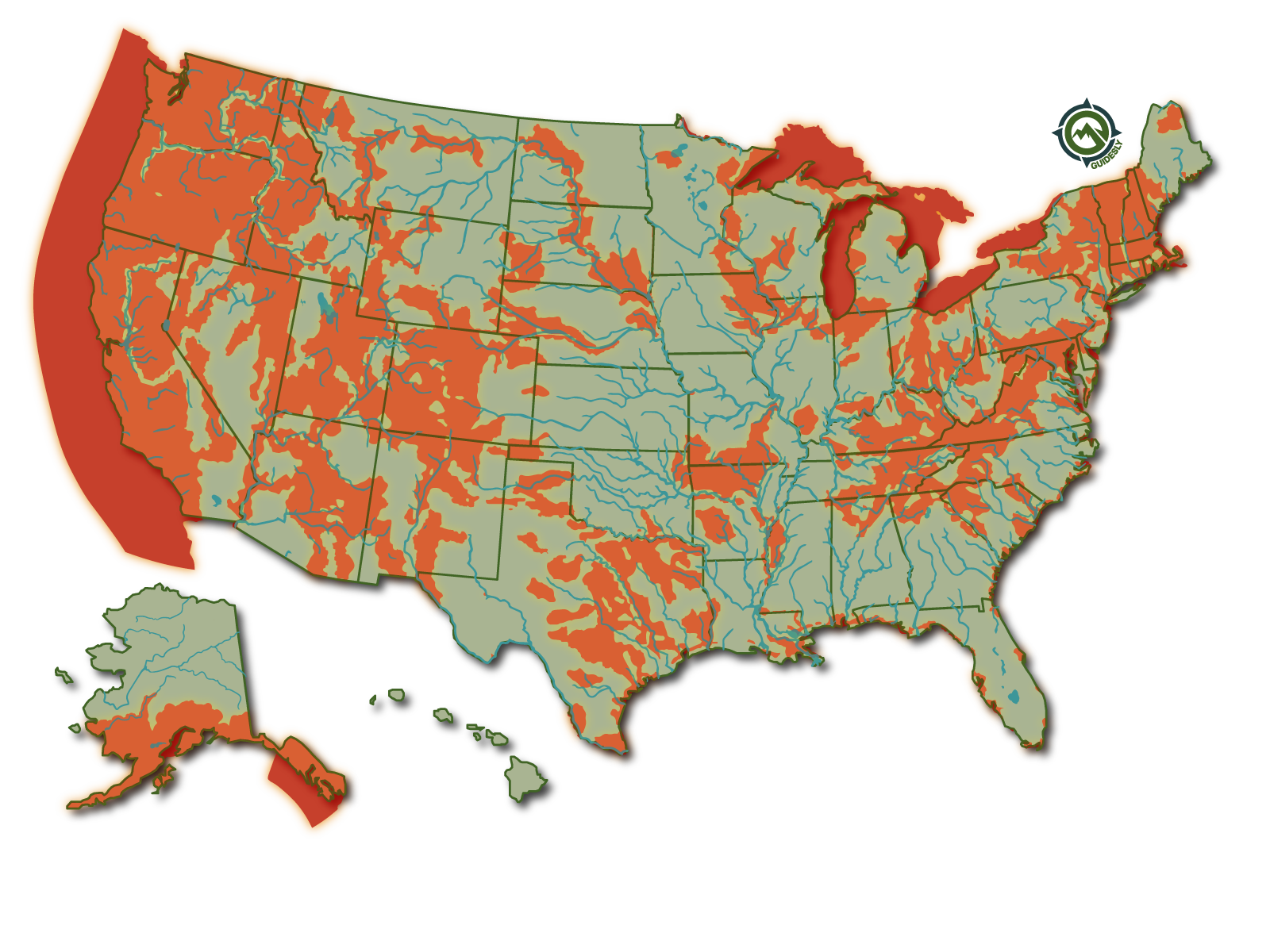
Oncorhynchus mykiss is an excellent game fish in northern America.it native to the west of Rockies. But now steelhead trout is introduced in the majority of states. It is also present on all continents. The only place that has no steelhead trout is Antarctica.
Steelhead Trout Weight and Length
The average length of Steelhead trout is 24 inches but there are reports of steelhead trout reaching 45 inches. 55 pounds is the maximum weight that is reported for steelhead trout.
Steelhead trout Interesting facts
- The life expectancy is 11 years.
- Steelhead trout spawn multiple times.
• They are migratory fish.
• Rainbow trout lives all its life in freshwater but steelhead trout spend life in the sea and only come to rivers to breed • Due to time spent in the marine environment, they develop a lot of black spots on the body.
Steelhead Trout Diet
They can eat anything like eggs, crustaceans, mollusks, small fish, and insects in adult age and when they are young they feed on zooplankton.
Steelhead Trout Best Fishing Techniques
The best techniques for this fish are drifting, plunking, back trolling, and fly fishing. For fly fishing, both double and single-handed rods can be equally effective. They can be helpful to drift a nymph rig or swing a fly in the water. Spey rods and switch rods are very popular for fly fishing. The handiest Spey rod is a 13.5-foot 7-weight rod. Steelhead fly fishing is challenging but the reward is a tremendous fight.
Steelhead Trout Baits and Lure
For wet swing, it is better to use number 6-number 8 flies that are tied thinly such as Golden Demon, Skunk, Brad’s Brat, Silver Hilton, Max Canyon, Surgeon General, Purple Peril, and Skykomish Sunrise. You can use a bomber as a dry fly.
Steelhead Trout Migration and Spawning
They show migratory behavior as they spent the majority of their adult years in the sea. They come to freshwater for spawning and then return. On the gravel of freshwater bodies such as tributaries, steelhead trout female lay eggs which are fertilized by the male. They can lay 9000 eggs at a time but it depends on the female steelhead trout size.
Steelhead Trout Season
The best time of year for catching starts in mid-fall and ends in spring. ## The Trout Family Trout are members of the family Salmonidae, order Salmoniformes. The native trout family is closely related to salmon. A top fly fishing family of fish that are both tremendous game fish and tasty eating fish. Found in small streams, large rivers, and any trout stream with the right water temperature, aquatic insects, and clean water. The trout species is usually restricted to freshwater, though a few types migrate to the sea between spawnings. Members of the trout species include Rainbow Trout, Brown Trout, Brook Trout, Lake Trout, Steelhead Trout, Bull Trout, Cutthroat Trout, Apache Trout and several other smaller species.
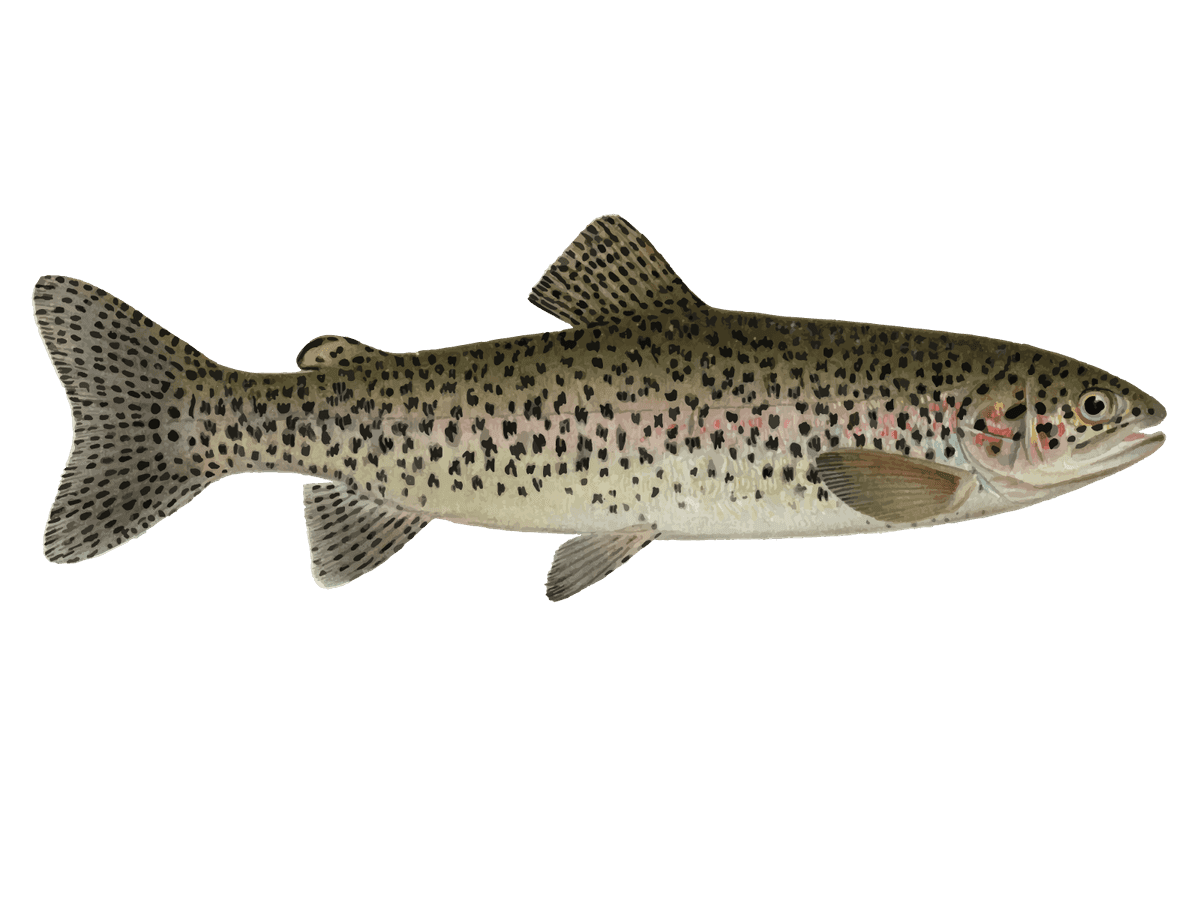
Walleye
Walleye (Sander Vitreus) Description
Walleye are freshwater fish that is a part of the perch family. They are a very popular game fish for the angler in the regions where they are found, and also a favorite for the dining table. Walleye are long and thin and have a golden and olive coloring with white bellies. One predominant feature of the walleye is its eyes, which have a silver eyeshine called the tapetum lucidum. This eyeshine greatly aids the walleyes when feeding in low-light conditions.

Walleye Habitat and Distribution

Walleye live in a wide range of habitats. In small to large rivers, to deep and shallow lakes. They are fairly particular to where they like to be in these bodies of water and see out sand, rock, or gravel bottoms. Walleye will usually stay deeper in the water column during daylight hours and use weeds, timber, or other structures for cover. In River systems, they will likely spend their daylight hours in deep holes and drop-offs, and move out into the shallows to seek forage during the lowlight period. Walleyes can tolerate water temperatures from 32 to 90 degrees Fahrenheit but are most comfortable when water temperatures are at 70 degrees. Walleye are nocturnal creatures that feed in shallow waters at night. Adult walleye primarily consume other fish. Small crustaceans and insects, primarily mayflies, are eaten by young walleye.
Walleye are found in the Arctic south of Canada down to the Great Lakes region and east to the St. Lawrence systems. Lake Erie is a well-known home of walleye anglers and great walleye fishing. The Midwest and Canada are the most popular areas with the best fishing, but over decades the species has been introduced artificially into lakes and reservoirs all over North America. The breathtaking waters of Lake of the Woods and Rainy River have earned the title of "Walleye Capital of the World." It has some of the best fishing in the world, and anglers come here year after year in search of that elusive record catch.
Typical Size and Weight
Walleye are reasonably large fish with a sleek and conical body shapes and a mouth lined with sharp teeth. the adult walleye can grow to 30 inches or more in length and top out at around 20 pounds in weight. Females generally grow larger than males.
Interesting Facts
The Walleye also has a European counterpart, the zander, that looks very similar but the zander can grow much larger and can reach a weight of 40 plus pounds.
The walleye can live for decades, with the oldest recorded fish being 29 years old. In areas with heavy fishing pressure however, Walleye usually don’t live past 5 or 6 years of age.
Fishing Techniques - How to Catch Walleye
Walleye can be a challenging game fish to pursue. Their location in a body of water and the tactics used to catch these fish can vary depending on certain times of the year. Walleye generally live at depths of 10 feet or greater, though in the spring and at night they can be found in shallow water areas. Freshwater fishing for walleye is best in the evening when minnow-style lures or jigs are fished near the bottom over rock piles or along the edges of weed beds.
Finding the fish is one of the biggest challenges for the walleye angler and the best place to start it by fishing structure. The angler should search multiple types of structure at varying depths to figure out where the walleye are on any given day. Be sure to check break lines, deep weed edges rock piles, and even in the middle of the basin for suspended schools of baitfish. With a little bit of time on water exploration, you will find the Walleye population.
Live bait is the key to successful Walleye catches such as minnows, nightcrawlers, and leeches. One of the best techniques is a live bait rig, to which you troll your lure slowly along the bottom. These rigs include a ¼ or a ½ pound sinker, a swivel, a 3 - 6 foot leader of a 6-pound fishing line, and a No. 4 or 6 hook.
Is Walleye Good to Eat
Walleye is a delicious fish making it a popular choice among seafood lovers. The mild, flaky texture of the fish along with its sweet, buttery flavor is enough to make anyone's mouth water. This makes walleye an excellent ingredient that pairs well with a wide variety of dishes. Whether you fry or grill it, walleye never fails to impress with its delicious taste. So, if you're looking for a healthy and tasty addition to your meals, walleye is definitely the way to go!
Walleye meat has a firm texture that holds up well to cooking methods such as grilling, frying, or baking. Its mild taste can be enhanced by seasoning it with herbs and spices or marinating it in your favorite sauce. Walleye also has low levels of mercury and other harmful contaminants, making it safe to eat regularly.
When preparing walleye, remove the skin and bones before cooking. This will give you a clean fillet.
However, it's not just its flavor that makes it so popular. Walleye is also a very nutrient-dense food that provides numerous health benefits. It's rich in omega-3 fatty acids, B vitamins, and selenium, all of which are essential for maintaining optimal health. Omega-3s are known to reduce inflammation in the body and improve heart health, while B vitamins play a crucial role in energy production and maintaining a healthy nervous system. Selenium is an important mineral that helps protect against oxidative damage and supports the immune system. By adding Walleye to your diet, you not only get the pleasure of savoring a delicious meal but also the nutritional benefits that come along with it. So, go ahead and indulge in this delectable fish to keep your body healthy and functioning at its best.

About the Albemarle
%2F%2Fusers%2F62a976e9-eb24-4dca-8698-3a9e06d0f6be%2Fvehicle_picture%2Fa268.jpg&w=1200&q=75)
Vehicle Guest Capacity: 4
Manufacturer Name: Mercruiser
Maximum Cruising Speed: 30
Number of Engines: 1
Horsepower per Engine: 375
%2Ffit-in%2F250x250%2Fguide_websites%2F6455%2Fimages%2Fdl_logo_png.png&w=1200&q=100)


%2Fusers%2F62a976e9-eb24-4dca-8698-3a9e06d0f6be%2Fimages%2Ffishing-in-buffalo-2403.jpg&w=768&q=75)
%2Fusers%2F62a976e9-eb24-4dca-8698-3a9e06d0f6be%2Fimages%2Ffishing-adventure-new-york-2348.jpg&w=768&q=75)
%2Fusers%2F62a976e9-eb24-4dca-8698-3a9e06d0f6be%2Fimages%2Ffishing-adventure-in-ny-2402.jpg&w=768&q=75)
%2Fusers%2F62a976e9-eb24-4dca-8698-3a9e06d0f6be%2Fimages%2Famerican-eel-fishing-buffalo-2373.jpg&w=768&q=75)
%2Fusers%2F62a976e9-eb24-4dca-8698-3a9e06d0f6be%2Fimages%2Fwalleye-fishing-buffalo-2381.jpg&w=768&q=75)
%2Fusers%2F62a976e9-eb24-4dca-8698-3a9e06d0f6be%2Fimages%2Fpike-perch-fishing-ny-2466.jpg&w=768&q=75)
%2Fusers%2F62a976e9-eb24-4dca-8698-3a9e06d0f6be%2Fimages%2Ffishing-adventure-in-ny-2403.jpg&w=768&q=75)
%2Fusers%2F62a976e9-eb24-4dca-8698-3a9e06d0f6be%2Fimages%2Fanglers-enjoy-fishing-buffalo-2386.jpeg&w=768&q=75)
%2Fusers%2F62a976e9-eb24-4dca-8698-3a9e06d0f6be%2Fimages%2Fsmallmouth-bass-ny-fishing-2420.jpg&w=768&q=75)
